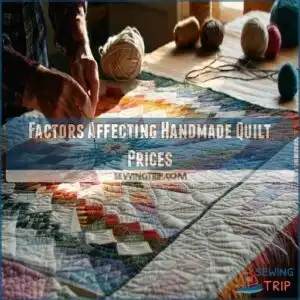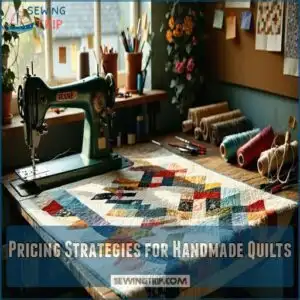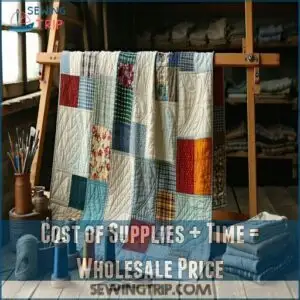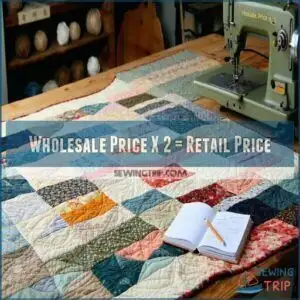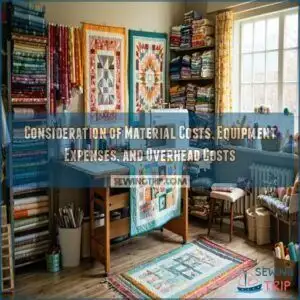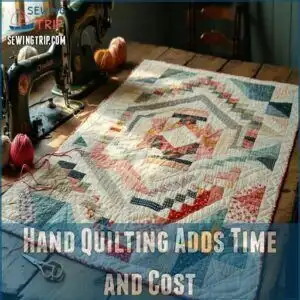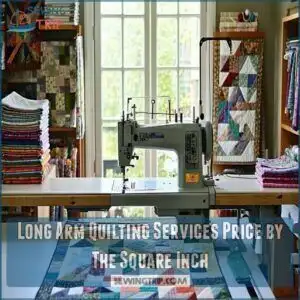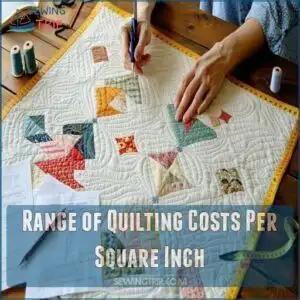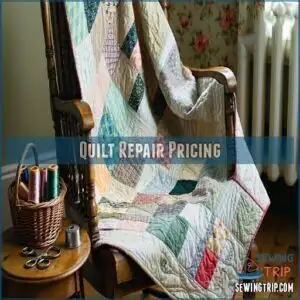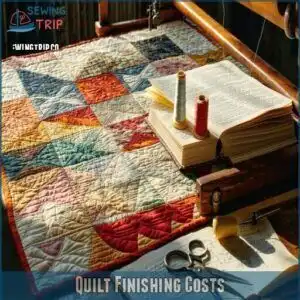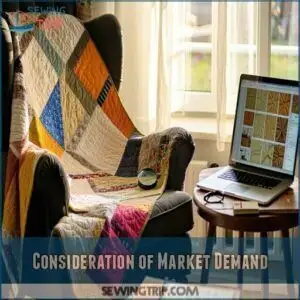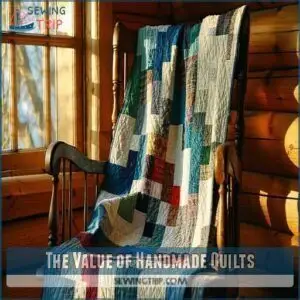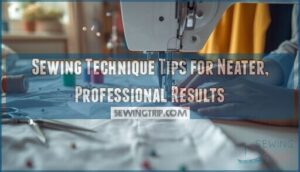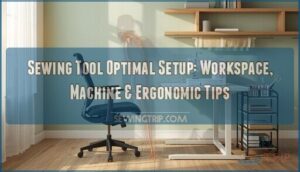This site is supported by our readers. We may earn a commission, at no cost to you, if you purchase through links.
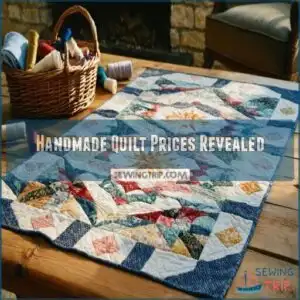
The price depends on factors like the quilter’s skill level, materials, design complexity, and time spent crafting.
Customization options, like color choices and fabric selection, also impact pricing.
With so many variables, it’s important to research and understand what goes into making a handmade quilt.
You’ll soon discover that the value lies not just in the price, but in the story and craftsmanship behind each stitch – and that’s just the beginning.
Table Of Contents
Key Takeaways
- You’ll need to consider factors like the quilter’s skill level, materials, design complexity, and time spent crafting when determining handmade quilt prices, as these all impact the final cost.
- To price your handmade quilts fairly, you should research competitors’ prices, avoid undercutting, and provide high-quality product descriptions and customer service to showcase your quilt’s unique value.
- The cost of repairs for a damaged quilt is calculated by evaluating damage, estimating labor hours, and adding material costs, considering the quilt’s original price and your hourly rate to determine a fair repair price.
- When selling handmade quilts, you should be patient and firm on fair prices, ignoring negative comparisons to mass-produced items, and focus on the customization options and the story behind each stitch.
Factors Affecting Handmade Quilt Prices
You’re about to discover the key factors that affect handmade quilt prices, including the skill and expertise of the artisan, material costs, and time spent on design and crafting.
As you explore these factors, you’ll gain a better understanding of how they impact the final price of a handmade quilt, helping you make informed decisions as a buyer or seller, considering the time spent on each piece.
Skill and Expertise of The Artisan
How skilled are you as a quilt maker? Your artisan training and quilt mastery impact handmade quilt prices.
Expert techniques and high skill levels increase the value of handmade quilts, affecting custom quilt cost and quilt maker prices when pricing handmade quilts, reflecting craftsmanship.
Understanding current quilt maker prices is essential for determining the value of handmade quilts.
Material Costs
Factoring in material costs is essential for accurate quilt pricing.
Think about your fabric expenses, batting prices, and thread costs. Smart material sourcing can save you money without sacrificing quality.
- Don’t forget yarn selection for embellishments!
- Even small things like the cost of quilting and fabric prices add up, which is why accurate pricing is crucial.
Time Spent on Design and Crafting
When pricing a handmade quilt, consider the time spent on design and crafting, as it substantially impacts labor costs.
Your design time, artisan skill, and production hours all factor into the quilt pricing formula, affecting the overall cost of this unique, handmade quilt.
Including crafting labor and complexity.
Complexity of The Quilt Pattern
You’ll find that quilt pattern complexity greatly affects handmade quilt pricing, as intricate designs require more time and skill, increasing costs.
Factors like stitch complexity, fabric selection, and color schemes contribute to quilt prices, making each handmade quilt unique and valuable, reflecting the quilt maker’s expertise and attention to detail.
Customization Options
When creating your dream quilt, consider customization options such as:
- Color Choices
- Fabric Selection
- Design Options
- Quilt Sizes
- Thread Types
These options impact pricing and make each quilt unique and valuable, reflecting your personal style with various customization choices.
Pricing Strategies for Handmade Quilts
You’ll need to develop a solid pricing strategy to guarantee you’re fairly compensated for your handmade quilts.
By researching competitors’ prices and avoiding undercutting, you can set prices that reflect the time, effort, and materials that go into creating each unique quilt, ensuring you’re fairly compensated.
Research Competitors’ Prices
When setting prices, research competitor pricing to inform your strategy, considering market analysis and pricing trends to establish a strong value proposition, ensuring your quilt pricing guide reflects fair wholesale and retail pricing, and helps you stand out amidst competitor prices.
To achieve this, consider factors affecting production cost calculations that impact your overall pricing strategy.
This approach will help you make informed decisions, ensuring that your pricing is competitive and reflects the value proposition of your quilts.
Avoid Undercutting Pricing Standards
Stand firm on fair pricing for your handmade quilts.
Educate buyers on the unique value of your craftsmanship—it’s what sets your quilts apart from mass-produced items.
Here are four key reminders to keep in mind:
- Market research is essential.
- Know the pricing ethics of your industry.
- Understand profit margins and competitive pricing.
- Use a pricing guide to guarantee fair rates.
Your time, skill, and effort have value. So, charge what your quilts are worth!
Provide High-quality Product Descriptions and Customer Service
When selling handmade quilts, provide detailed product descriptions and exceptional customer support to showcase your quilt’s value.
Highlighting fabric selection and quilt photography is crucial to boost buyer engagement.
Ultimately, justifying pricing handmade quilts with a clear quilt pricing formula that reflects the handmade quilt value is essential.
Be Patient in Selling at Fair Prices
You’ve crafted compelling descriptions and provided excellent service, now be patient and firm on fair prices, ignoring negative comments, to maintain your handmade quilt’s value.
Focusing on pricing strategies that reflect the fair market, and recognizing your worth as a patient seller in the handmade quilt prices field.
Ignore Negative Comparisons to Mass-produced Items
Don’t compare your handmade quilts to mass-produced items.
Value your labor and unique selling point.
Handmade value lies in quality focus, custom pricing, and artisanal worth, reflecting the true cost of handmade quilts and the quilt pricing formula that determines their worth.
Quilt Pricing Formula
You’ll calculate the price of your handmade quilt by adding the cost of supplies and time to determine the wholesale price.
Then, you’ll be able to set a fair and profitable price for your unique, handmade quilts by considering material costs, equipment expenses, and overhead costs, and doubling the wholesale price to get the retail price.
Cost of Supplies + Time = Wholesale Price
To calculate the wholesale price of a handmade quilt, add material costs and labor hours.
Consider supply chains, production time, and wholesale rates. Your quilt pricing formula should reflect the time and effort invested.
A comprehensive cost breakdown is essential for profitability.
Factor in material costs, then calculate labor hours based on your rate. This makes sure a fair wholesale price for your handmade quilts, covering costs and valuing your time.
Wholesale Price X 2 = Retail Price
Now that you’ve determined your wholesale price, it’s time to calculate the retail price.
Simply double your wholesale price to guarantee a fair profit margin.
This quilt pricing formula, known as doubling the wholesale price, helps you set a retail price that covers costs and generates profit, making your handmade quilts competitively priced.
Consideration of Material Costs, Equipment Expenses, and Overhead Costs
Beyond doubling your wholesale price, understanding your true costs keeps your quilt business thriving.
When pricing your handmade masterpieces, you’ll need to track more than just fabric and thread. Here’s what smart quilters include in their calculations:
- Supply chain costs: fabric sourcing, batting selections, and specialty threads
- Equipment investments: sewing machines, cutting tools, and workspace setup
- Overhead fees: utilities, studio rent, and business insurance
Think of these expenses like the batting in your quilt – they might be hidden, but they’re essential to holding everything together.
Accurate quilt pricing also involves considering quilt pricing strategies to make sure fair and competitive pricing for your handmade quilts, which is crucial for the success of your quilt business.
Hand Quilting Vs. Long Arm Quilting Costs
You’ll notice a significant price difference between hand quilting and long arm quilting services, with hand quilting taking more time but offering that extra personal touch.
If you’re deciding between the two methods, you should know that long arm quilting services typically charge by the square inch, which can help you better plan your budget.
Hand Quilting Adds Time and Cost
The artistry of hand quilting transforms your project into a unique masterpiece, but it comes with additional time investments and costs that affect handmade quilt prices.
Here’s why choosing hand stitching over machine methods impacts your bottom line:
| Factor | Hand Quilting Impact |
|---|---|
| Crafting Time | 40-60 hours longer |
| Labor Cost | $15-35 per hour extra |
| Quilt Complexity | Higher detail possible |
| Material Selection | Premium materials required |
| Pricing Formula | 2-3x machine quilting |
Your hand-quilted creation requires diligent attention to each stitch, whether you’re using traditional techniques like the rocking stitch or creating intricate custom patterns.
While machine quilting offers efficiency, hand quilting provides that irreplaceable human touch that collectors and enthusiasts treasure, and your time and expertise deserve fair compensation.
Long Arm Quilting Services Price by The Square Inch
Long arm quilters streamline their Quilting Rates by charging per square inch, making pricing transparent and consistent.
You’ll find this square inch pricing model helps calculate costs quickly for any quilt size.
| Quilt Component | Basic Rate | Standard Rate | Premium Rate |
|---|---|---|---|
| Edge-to-Edge | $0.015/sq in | $0.025/sq in | $0.035/sq in |
| Custom Design | $0.025/sq in | $0.035/sq in | $0.045/sq in |
| Stitch Density | $0.020/sq in | $0.030/sq in | $0.040/sq in |
| Fabric Costs | included | included | included |
The provided table outlines the pricing model with different rates for various quilt components, including Edge-to-Edge, Custom Design, and Stitch Density, with Fabric Costs included in each.
Range of Quilting Costs Per Square Inch
Quilting costs per square inch vary widely between hand and long arm methods.
Here’s a breakdown of typical pricing:
| Method | Simple Design | Complex Design | Size Factor | Time Investment | Material Fees |
|---|---|---|---|---|---|
| Hand Quilting | $0.10-0.25 | $0.30-0.60 | +15% for king | 40-80 hours | $3-7/yard |
| Long Arm | $0.02-0.03 | $0.04-0.08 | +10% for king | 3-10 hours | $2-5/yard |
When calculating your quilt pricing formula, remember labor rates typically represent 60-70% of your production expenses, and consider the time investment required for each method.
Quilt Repair Pricing
You’ll need to carefully assess quilt damage and replacement materials before setting your repair prices, just like a doctor diagnosing before prescribing treatment.
When pricing quilt repairs, you can follow the same formula used for new quilts (materials + time), with special consideration for vintage pieces that often command premium rates.
Assessment of Damage and Material Replacement
Shifting from comparing quilting techniques to repair evaluation, evaluating quilt damage requires a keen eye and expertise. When examining a damaged quilt, document each issue methodically for accurate repair pricing.
- Fabric tears require matching replacements ($8-15/yard)
- Batting damage evaluation impacts structural integrity
- Color-matching vintage fabrics often increases costs by 30%
- Border or binding damage requires evaluation of entire edging
Use of Quilt Pricing Formula for Repair Services
When repairing treasured quilts, apply the standard quilt pricing formula: Materials + Labor = Wholesale × 2 = Retail Price.
You’ll need to assess damage carefully, estimating replacement fabric costs and repair time. For a typical torn seam repair, expect to spend 1-2 hours at your hourly rate plus materials.
Remember, vintage quilts often require specialized handling, which may justify higher service fees.
Accurate quilt repair also involves understanding fabric tear assessment to determine the best approach for each unique damage, considering the best approach for a successful repair.
Developing a Specific Repair Rate
When establishing a specific repair rate for quilts, start with a thorough damage assessment.
Your pricing model should reflect both expertise and complexity.
Calculate your rate based on:
- Your skill level and regional market rates ($15-35/hour is standard)
- Estimated restoration time for specific damage types
- Material costs for authentic replacements
Track your actual repair times on different projects to refine your quilt repair pricing formula.
Remember, clients aren’t just paying for materials—they’re investing in your specialized restoration knowledge that mass retailers can’t provide.
Charging for Repairing Vintage Quilts
When restoring vintage quilts, consider damage, sentimental value, and historical significance.
Factor in fabric replacement and repair estimates to determine quilt repair costs.
Repairing vintage quilts requires expertise, affecting quilt repair pricing, with longarm quilting services often necessary for intricate vintage quilt restoration, impacting overall costs.
Quilt Finishing Costs
You’re about to learn how quilt finishing costs impact the overall price of a handmade quilt.
As you calculate these costs, you’ll consider factors like long arm quilting services, quilting design complexity, and quilt size to determine the total cost of finishing your quilt.
Explanation of Long Arm Quilting Services and Pricing
To wrap things up, let’s talk long arm quilting services and pricing. Think of it as the fairy godmother of quilt finishing.
Here’s the deal:
- Long Arm Pricing varies by quilter.
- Quilting Rates depend on complexity.
- Service Costs often include batting and thread.
- Quilt Estimates should be itemized.
Finding the right longarm quilting service can feel like searching for a needle in a haystack, but don’t worry! Custom quilting services offer a range of stitch options and quilting prices to fit your budget.
Research long arm quilting services near you and request quotes. Knowing the average quilting prices and longarm quilting costs will help you budget effectively.
Understanding stitch regulator systems is essential for achieving professional results in long arm quilting services.
Charges for Different Types of Quilting Designs
You’ll find various quilt patterns with associated design fees, stitch types, and quilting rates affecting handmade quilt prices.
Consider fabric costs when pricing a custom made quilt, using a quilt cost estimator with criteria for pricing quilts to determine the total cost.
Understanding quilt design prices is essential for estimating the overall expense of a handmade quilt with custom made considerations.
Calculation of Total Cost Based on Quilt Size and Design Complexity
You calculate total quilt cost considering size and complexity.
Four key factors include:
- Quilt Sizing
- Material Costs
- Labor Hours
- Complexity Factors.
Use a quilt pricing calculator or estimator with your pricing formula to guarantee fair prices, accounting for quilt materials and labor, considering the complexity of the quilt.
Description of Various Long Arm Quilting Options
When finishing your handmade quilt, consider longarm quilting services, offering various Quilting Styles and Stitch Options.
| Quilt Finishing | Cost |
|---|---|
| Basic | $100 |
| Custom | $200 |
| Heirloom | $300 |
| Wholesale | $400 |
| Retail | $500 |
This enhances your quilt with unique Thread Choices and Batting Types, affecting quilt pricing and handmade quilt prices, considering custom quilting and quilt making costs.
Consideration of Market Demand
You’ll need to evaluate market demand when pricing your handmade quilts, taking into account what similar quilts are selling for online.
By researching online marketplaces, you can determine the going rate for quilts like yours, such as queen size or baby quilts, and adjust your prices accordingly to ensure you are competitive in the handmade quilts market.
Queen Size Quilt Price Range
Queen-size quilts are a hot commodity, and pricing them right is key.
You’ll want to evaluate these factors that influence the value of your handmade masterpiece:
- Materials: The type and quality of fabrics make a difference.
- Time and Labor: The hours spent designing and quilting, along with your hourly rate, contribute to the overall cost.
- Design Complexity: Intricate patterns and custom designs add value.
- Size Variations: Bigger quilts demand more materials and time, pushing the price higher.
Let’s explore these factors and more to understand queen-size handmade quilt prices.
Baby Quilt Price Range
When pricing a baby quilt, consider these factors:
- Fabric Costs
- Quilt Materials
- Quilt Sizing
- Price Factors, to determine its handmade baby quilt value chart and average price for handmade quilts, affecting baby quilt prices and overall handmade quilt prices online.
The key factors include quilt materials and sizing, which play a crucial role in determining the price of a handmade baby quilt.
Researching Online Marketplaces for Pricing Comparisons
Research online marketplaces like Etsy to compare handmade quilt prices, considering factors like size and long arm quilting costs, to set competitive prices, and stay updated on marketplace trends, quilt auctions, and digital sales.
To make sure your online listings reflect current quilt prices online and attract buyers, understanding Etsy search algorithms is essential for optimizing your listings and reaching potential customers, which involves staying informed about marketplace trends and utilizing this knowledge to improve your online listings.
Adjusting Price if Necessary to Meet Market Demand
You may need to adjust your handmade quilt prices based on market trends and demand analysis.
Consider customer feedback and competitive pricing to inform your pricing strategy, ensuring your quilt market prices are elastic and meet customer demands.
Guiding your pricing guide for handmade quilts effectively is crucial, as it ensures that your prices are informed by both market trends and customer needs.
The Value of Handmade Quilts
You’re about to discover the value of handmade quilts, which is rooted in their unique craftsmanship, high-quality materials, and personalization options.
By understanding what makes these quilts special, you’ll appreciate the time and expertise that goes into creating them, and why they’re worth every penny, due to their unique craftsmanship.
Unique Craftsmanship and Individuality
You appreciate unique craftsmanship and individuality in handmade quilts, reflecting artisan skills and custom designs.
Making each a treasured part of quilt heritage, with a personal touch that justifies handmade quilt prices, emphasizing the value of handmade quilts and custom handmade quilts.
Durability of High-quality Materials
Investing in a handmade quilt means owning a durable, long-lasting piece.
High-quality materials, like threads and fabrics, provide warmth and insulation, while resisting stains and wear, making them a valuable investment.
Reflecting in handmade quilt prices, considering quilt material costs and the overall value of handmade quilts.
Personalization and Customization Options
Beyond their durability, handmade quilts offer unparalleled personalization. Imagine choosing your color options and fabric choices!
Custom quilts reveal a world of possibilities:
- Size variations to perfectly fit your space.
- Custom quilt designs reflecting your unique style.
- Personalized gifts with a handmade quilt price formula sheet for that special someone.
This transforms a quilt from a simple blanket into a treasured heirloom—a tribute to your individuality.
Recognizing The Value of Time and Expertise in Quilt Making
You recognize the value of time and expertise in quilt making, considering labor costs and skill levels.
You can assess quilt expertise based on three categories: High, Medium, and Low, each associated with a specific time value.
| Quilt Expertise | Time Value | Labor Costs |
|---|---|---|
| High | High | $20-$35/hour |
| Medium | Medium | $15-$25/hour |
| Low | Low | $10-$20/hour |
Frequently Asked Questions (FAQs)
What Are Some Common Challenges Faced When Wholesaling Handmade Quilts?
When diving into wholesaling handmade quilts, you’ll hit a brick wall with pricing and competition challenges, making it tough to turn a profit and stand out in a crowded market.
How Do You Calculate the Cost of Repairs for a Damaged Quilt?
You calculate repair costs by evaluating damage, estimating labor hours, and adding material costs, considering the quilt’s original price and your hourly rate to determine fair repair price.
How much do handmade quilts sell for?
You’ll find handmade quilts selling for $275 to $1,200+, depending on size, materials, and complexity, with prices varying like a patchwork of possibilities, each one unique and carefully crafted.
How much should you pay someone to make a quilt?
You should pay a quilter based on time, skill, and materials, considering factors like complexity, size, and labor hours, with prices ranging from $3 to $15 per square inch.
How much do people charge to quilt a quilt?
Like a puzzle, quilting prices vary, but you’ll typically pay $3 to $15 per square inch, depending on complexity, materials, and the quilter’s skill level and experience.
How do you charge for hand quilting?
You charge for hand quilting based on complexity, size, and time, considering labor costs, materials, and overhead to determine a fair price for your unique, handmade creations.
What are some common challenges faced when wholesaling handmade quilts?
You’ll face challenges like low profit margins, high competition, and difficulty in setting prices when wholesaling handmade quilts, which can be overwhelming and affect your business’s overall success greatly.
How do you calculate the cost of repairs for a damaged quilt?
You calculate repair costs by evaluating damage, estimating labor hours, considering the quilt’s original price and your hourly rate to determine a fair repair price quote.
How to ship quilts safely and efficiently?
You’ll want to carefully wrap, box, and insure your quilts to ship them safely and efficiently, using sturdy materials and tracking services to prevent damage.
What insurance options are available for quilts?
You can explore insurance options like homeowner’s policies, quilt-specific coverage, or shipping insurance to protect your quilts from damage or loss, giving you peace of mind and financial security always.
Conclusion
You’ll find that 70% of handmade quilt buyers prioritize uniqueness, which is reflected in handmade quilt prices.
When researching, consider the value of customization and craftsmanship that goes into each handmade quilt, making it a one-of-a-kind piece, and that’s what you’re paying for with handmade quilt prices.
- https://cabbagerosequilting.com/wondering-how-to-price-your-handmade-quilts-heres-your-complete-guide/
- https://jitterywingsquiltco.com/cost-of-a-handmade-quilt
- https://gaillizette.com/2023/01/how-much-does-a-handmade-quilt-cost/
- https://en.wikipedia.org/wiki/Quilting
- https://corporatefinanceinstitute.com/resources/knowledge/accounting/profit-margin/

